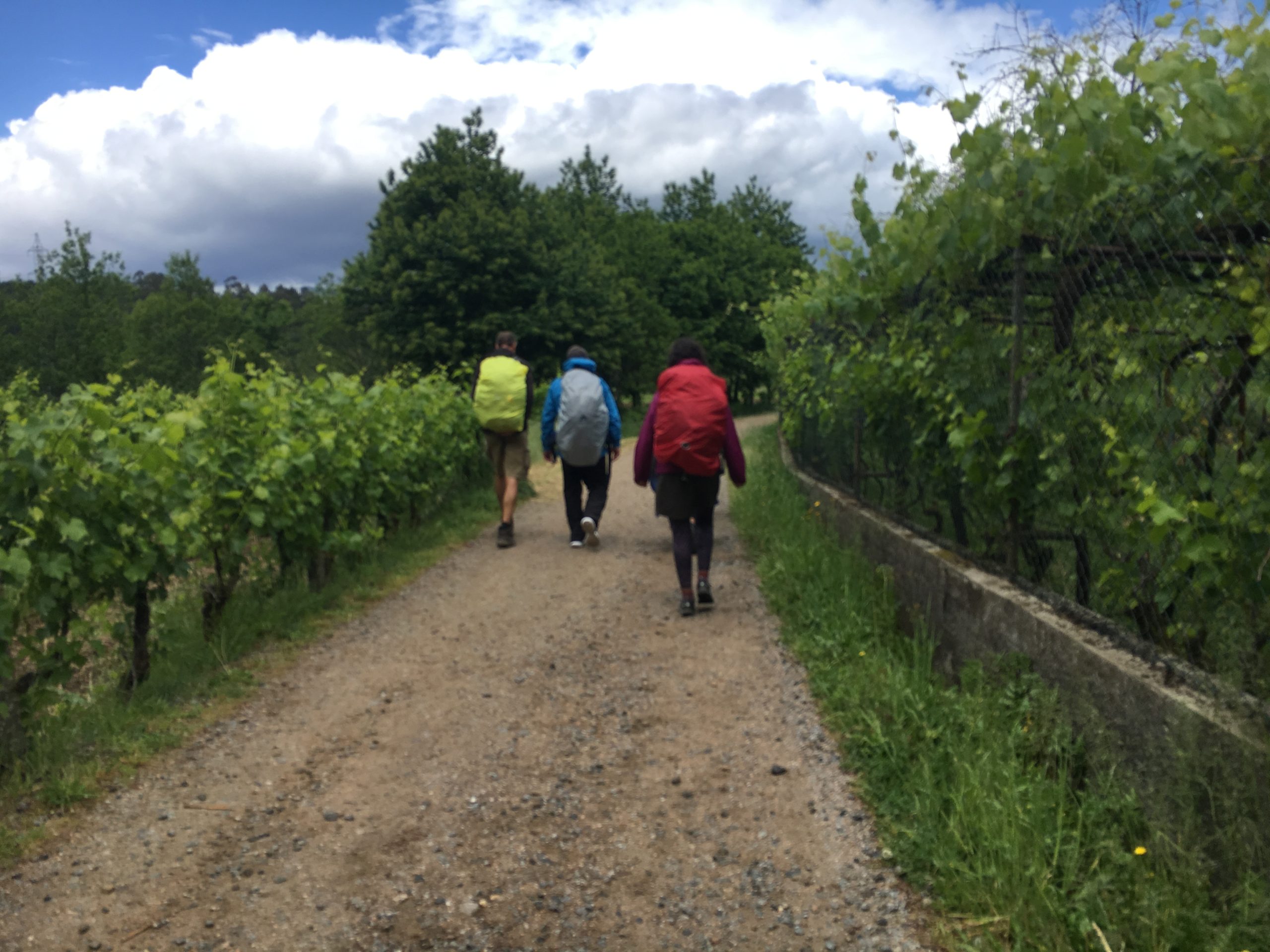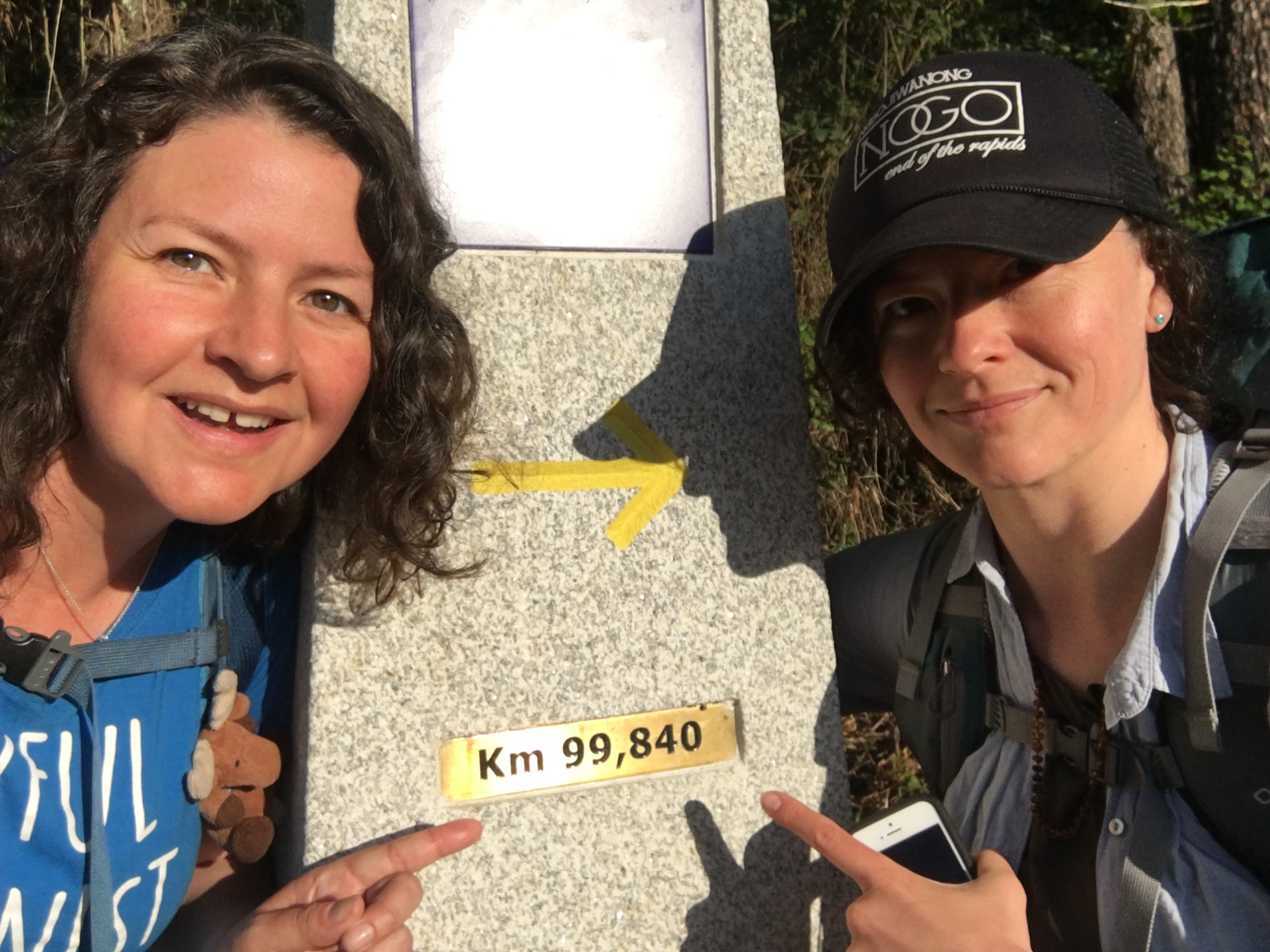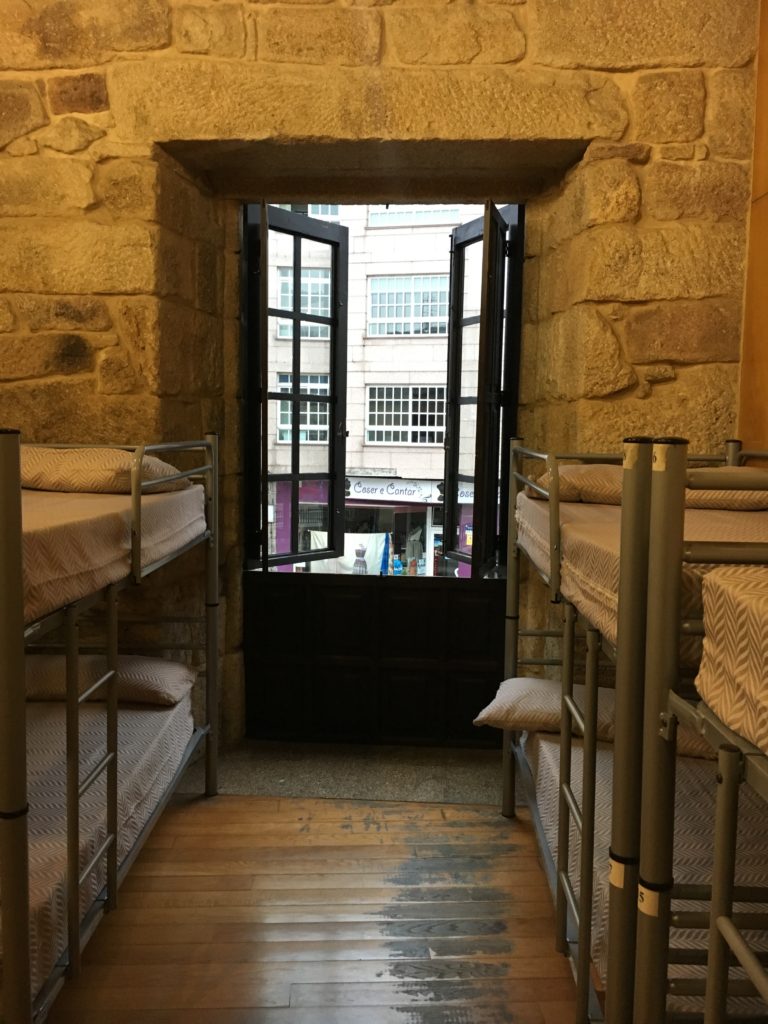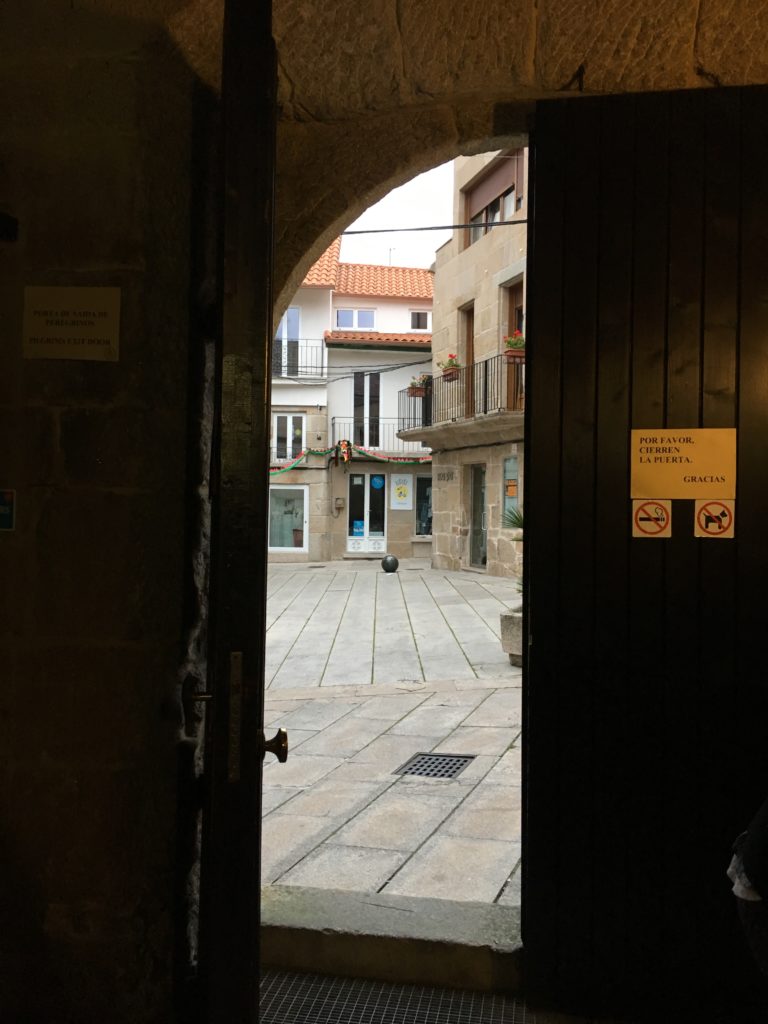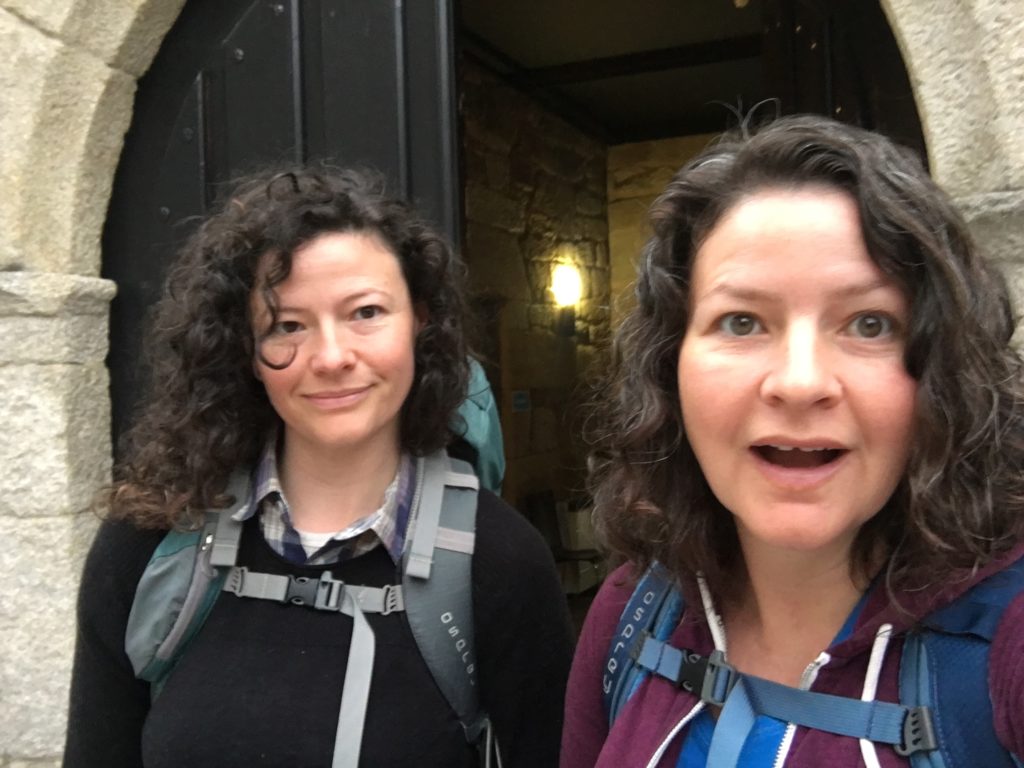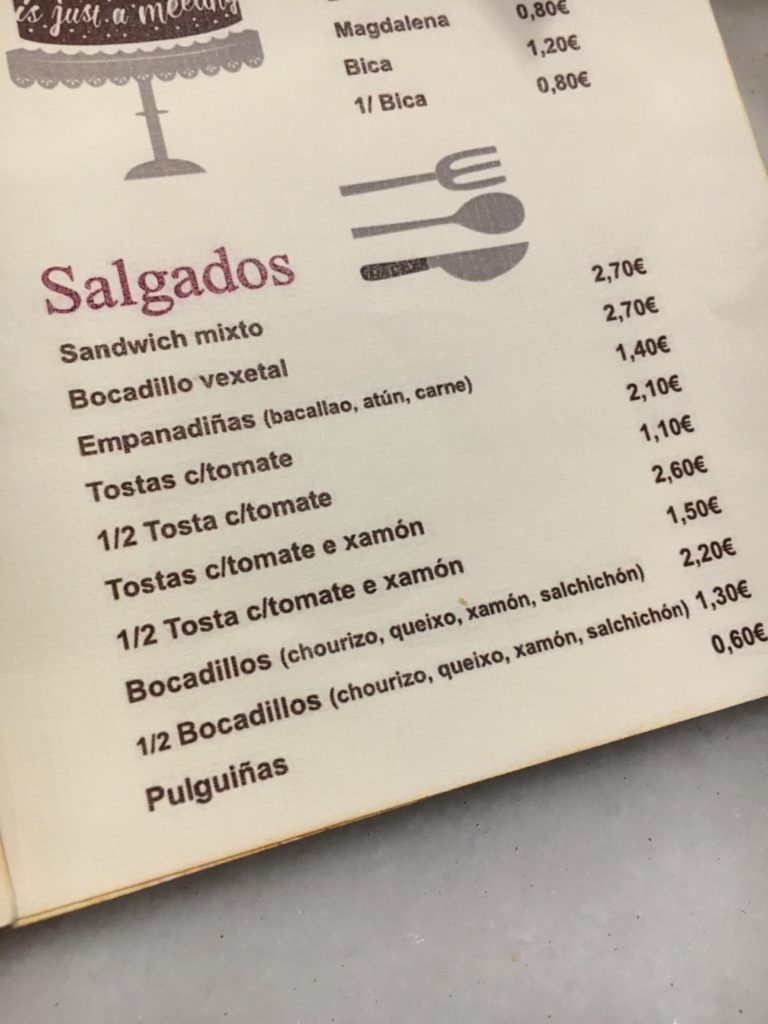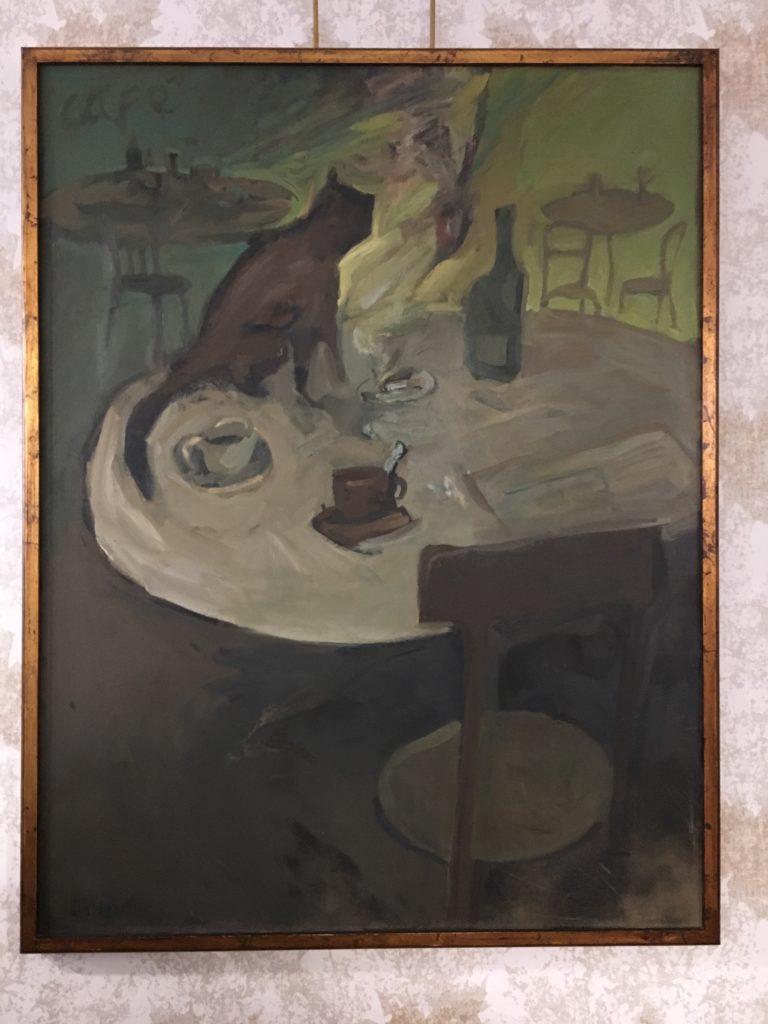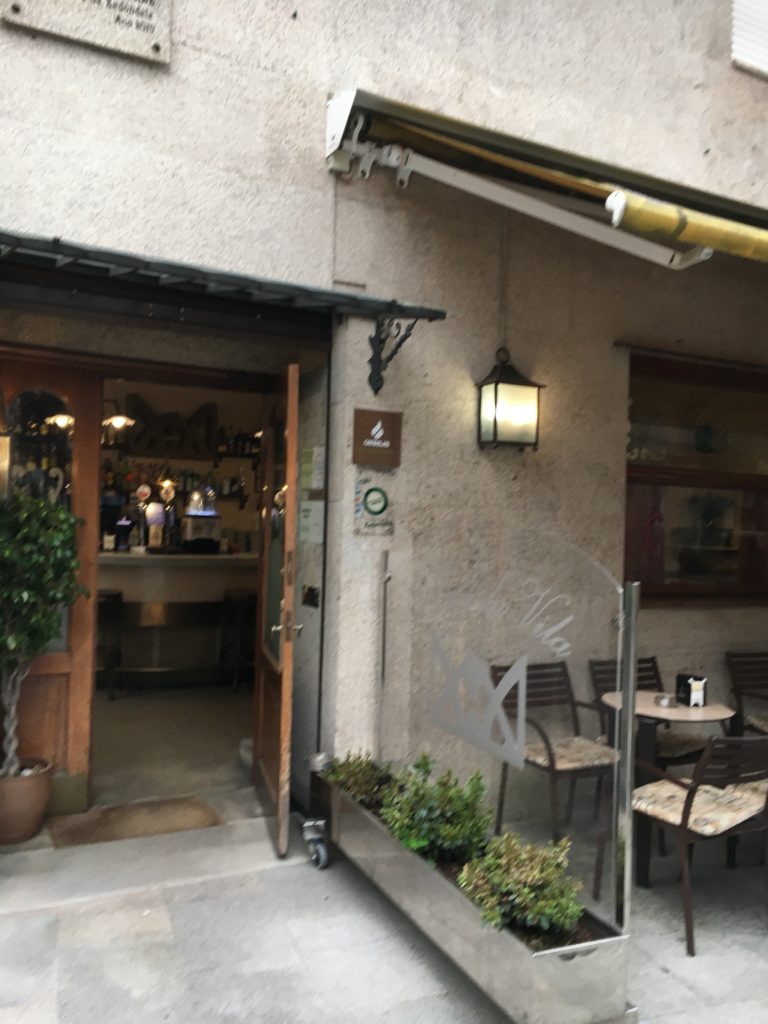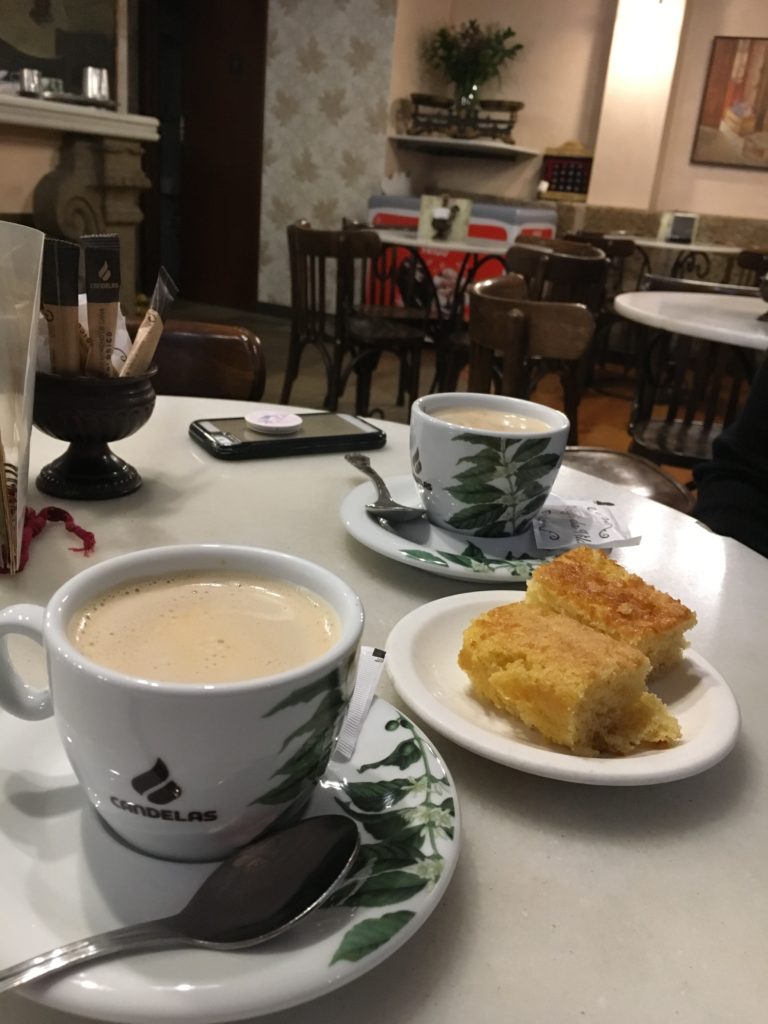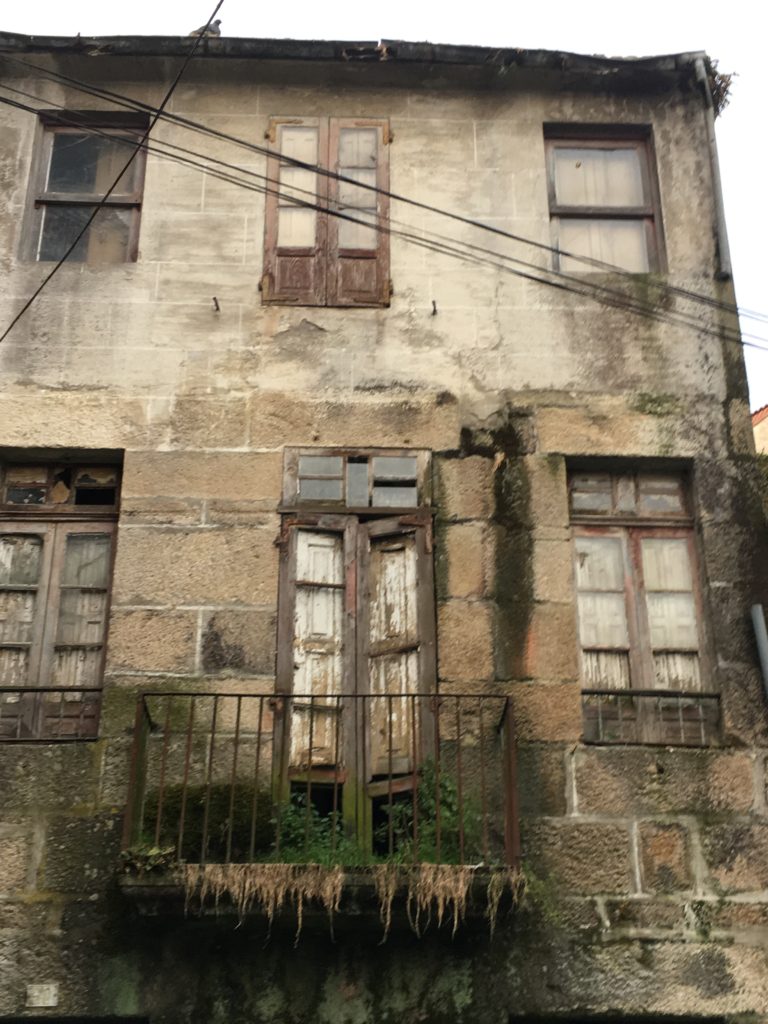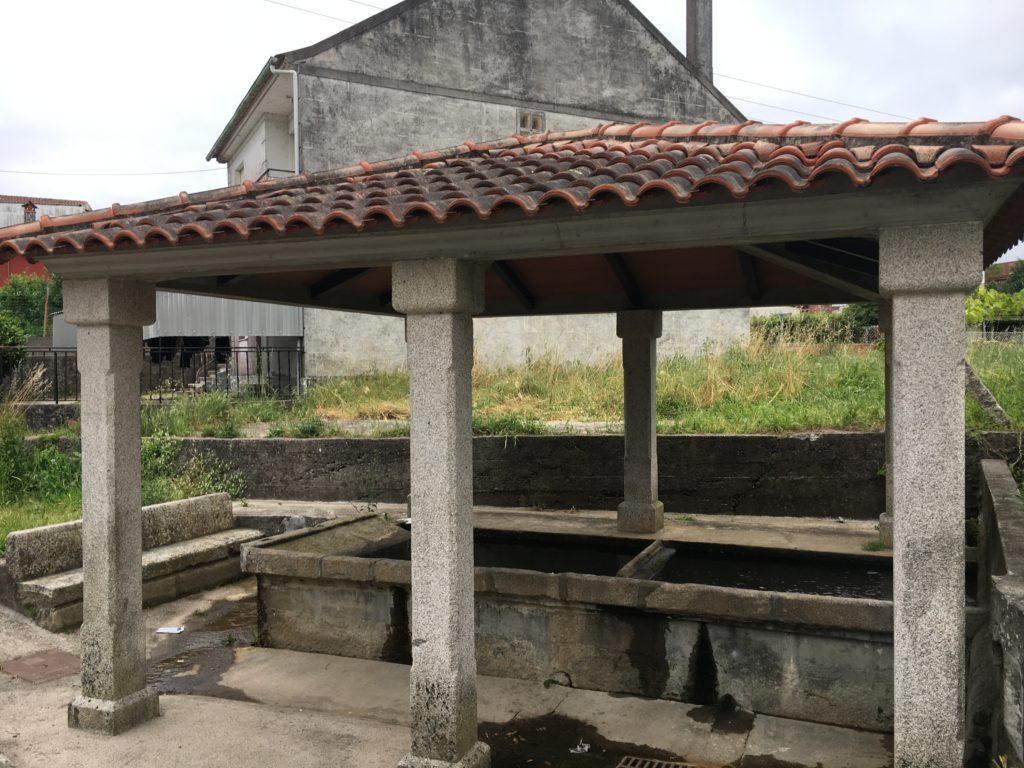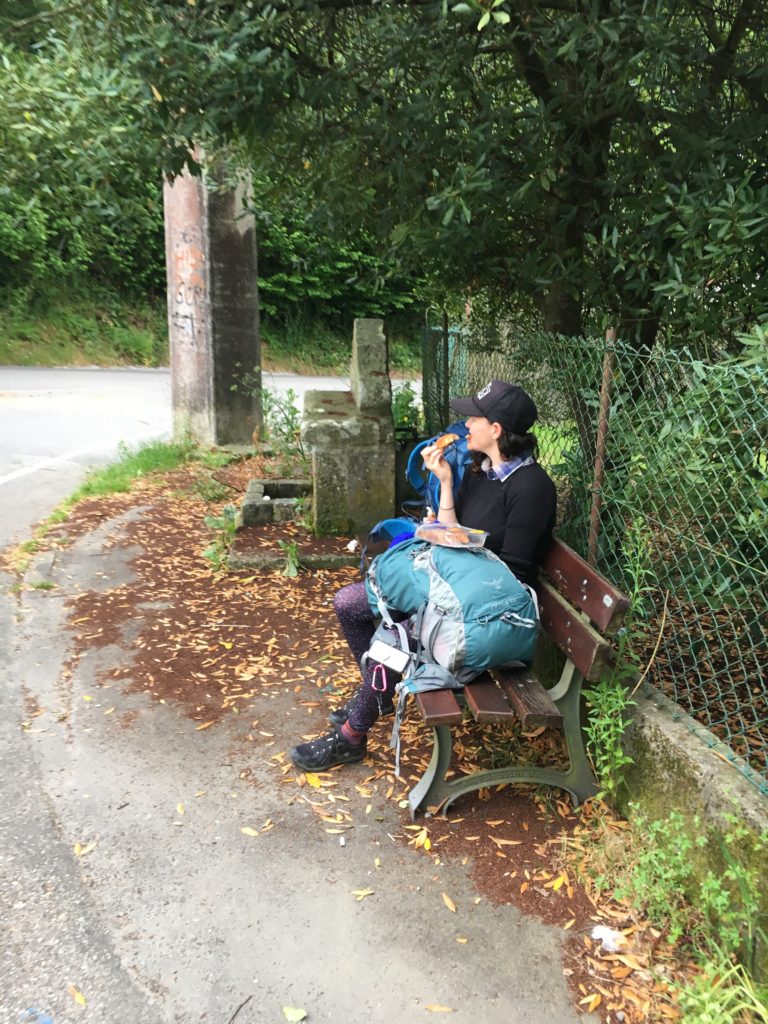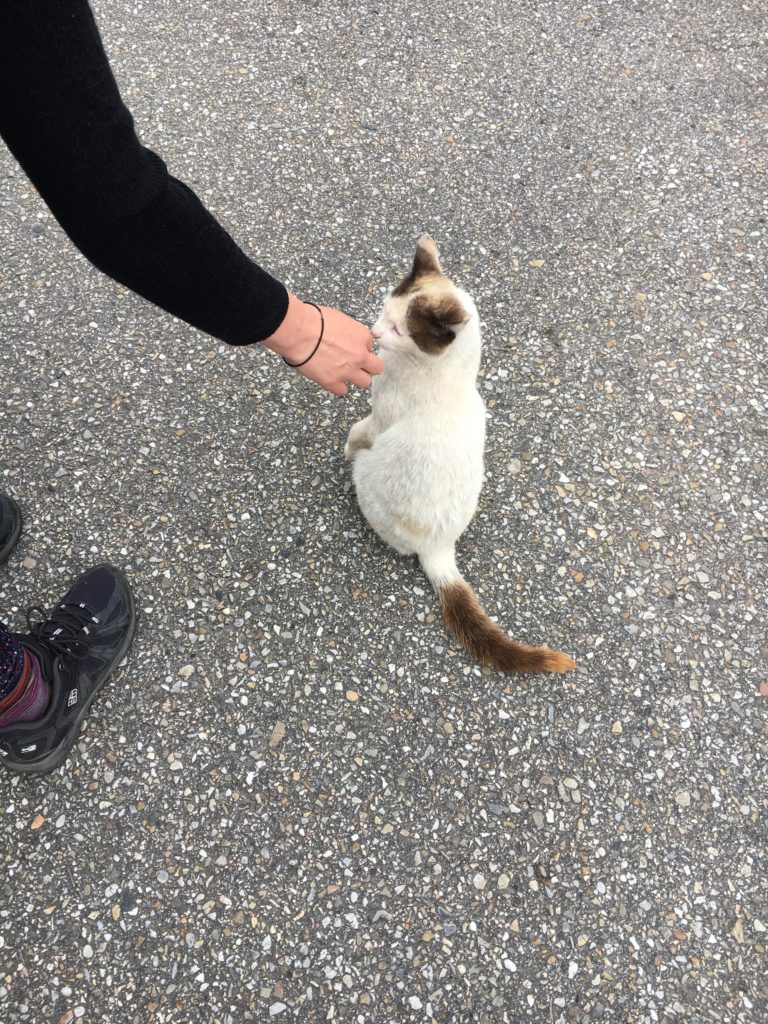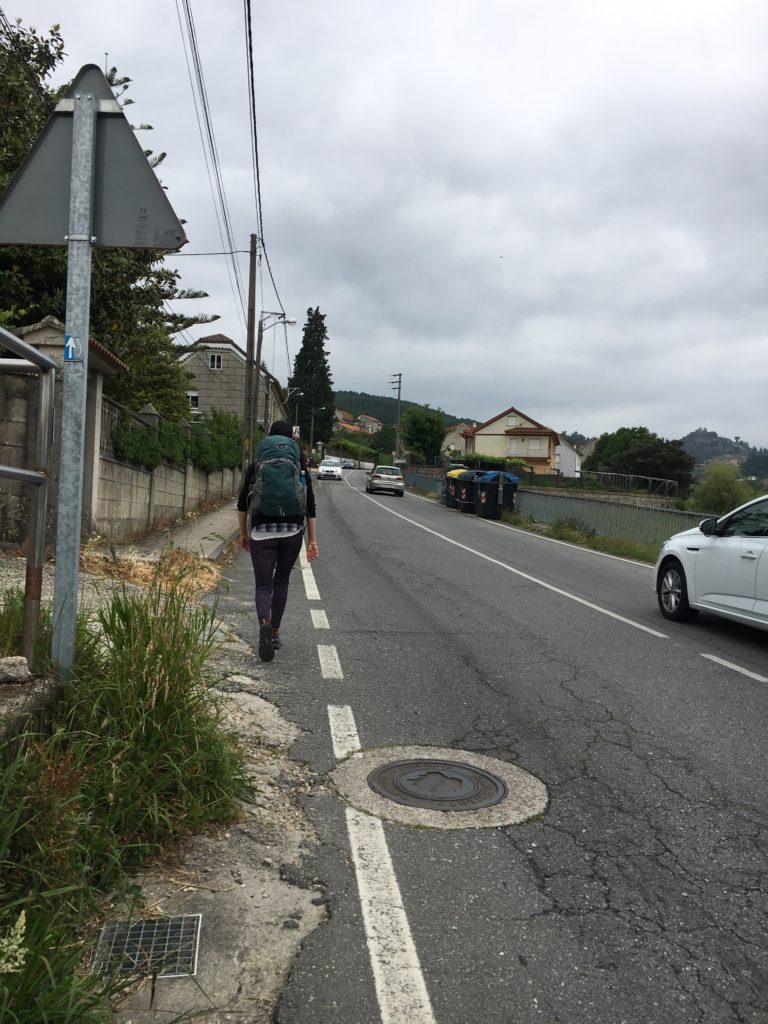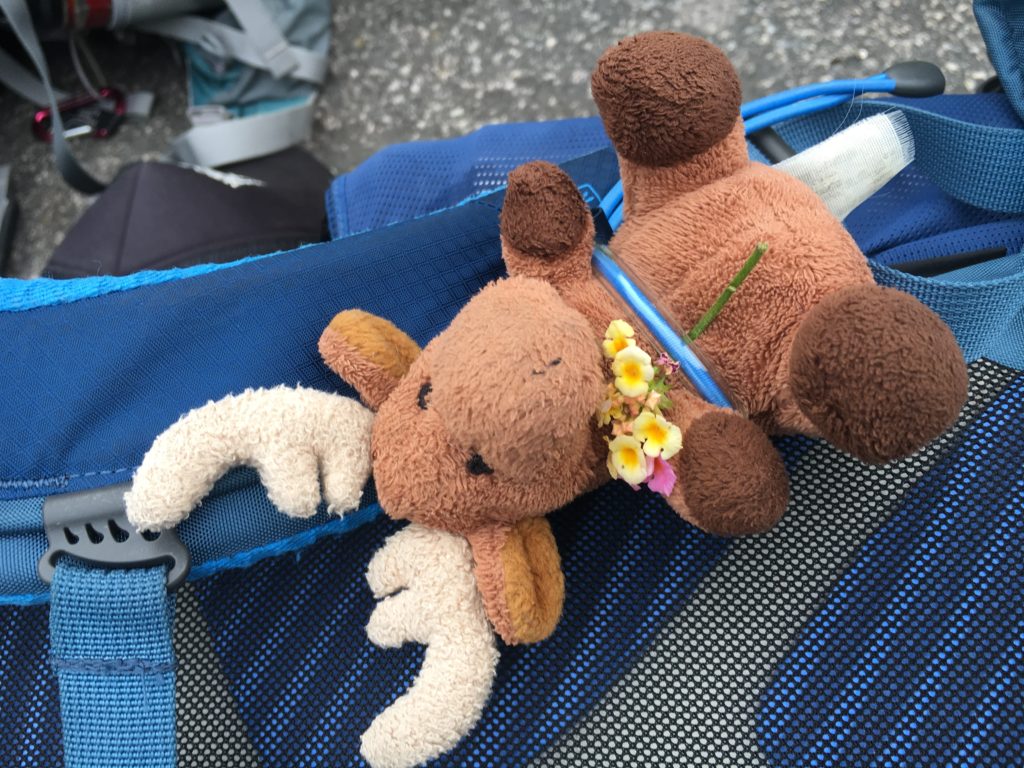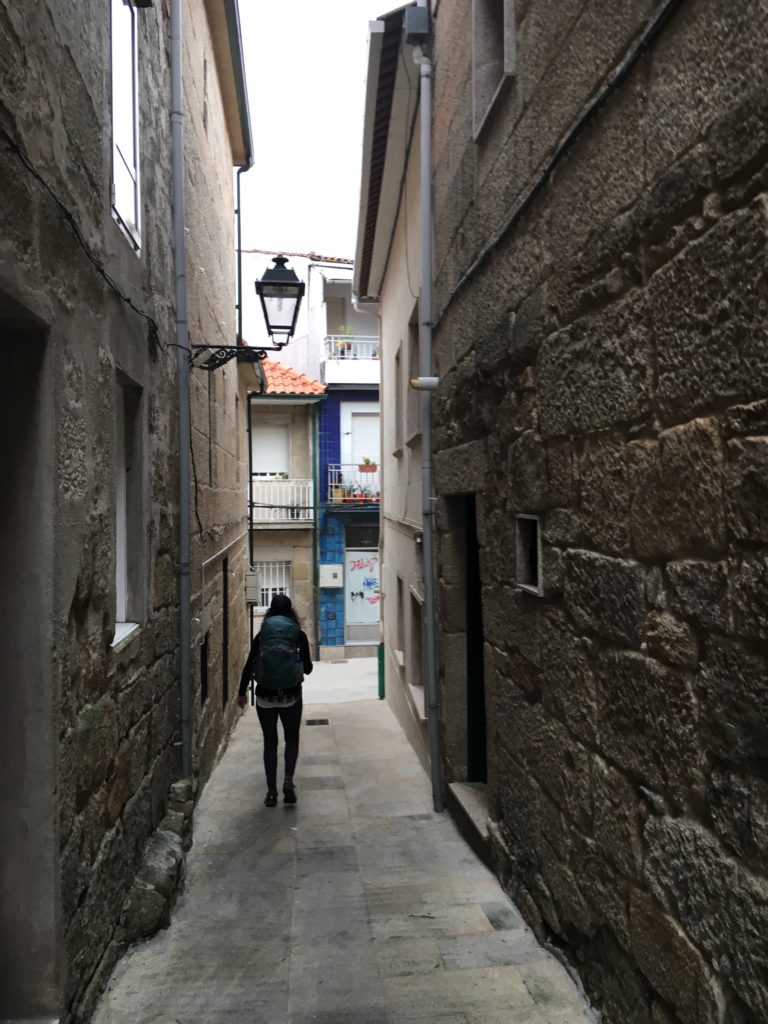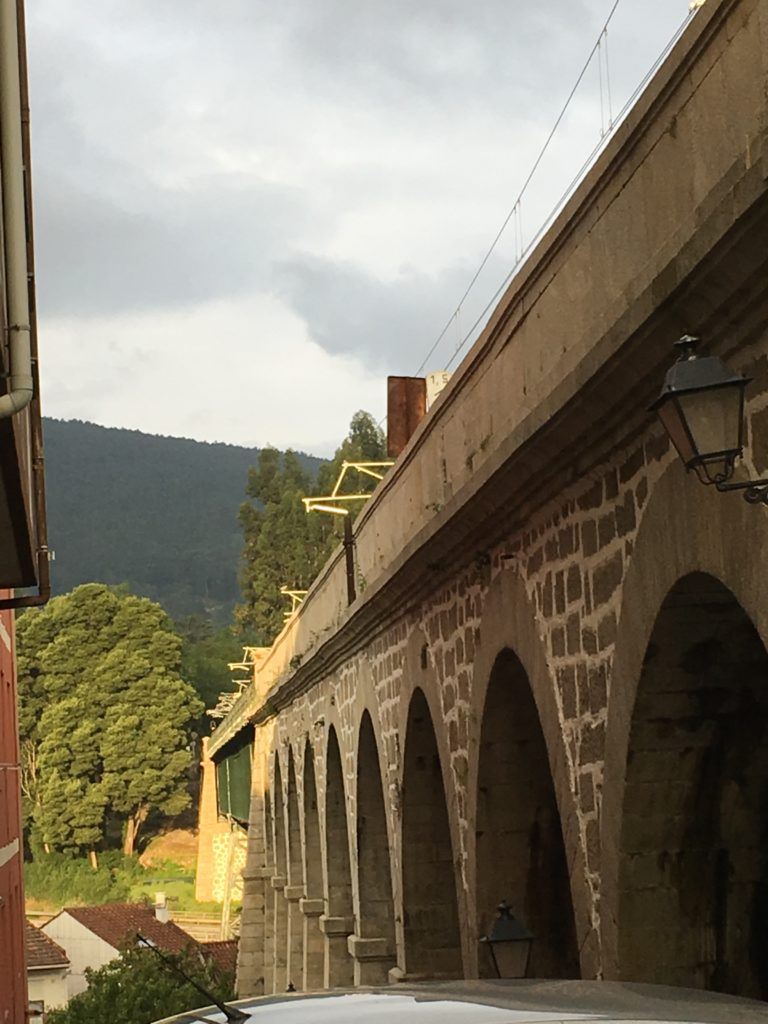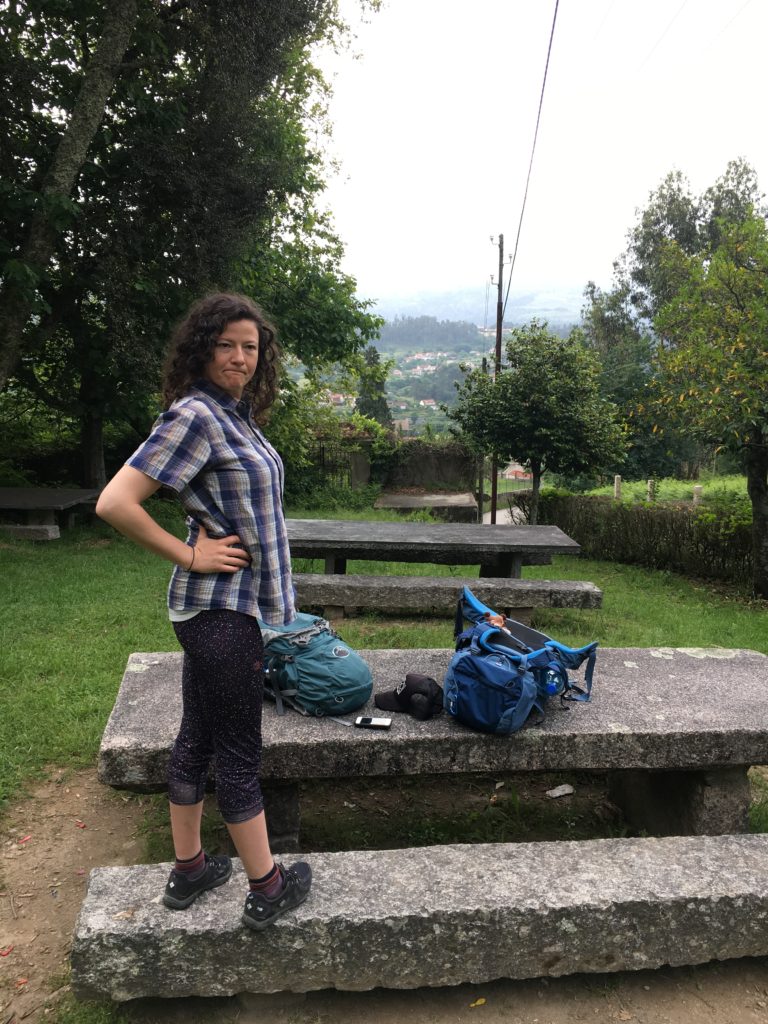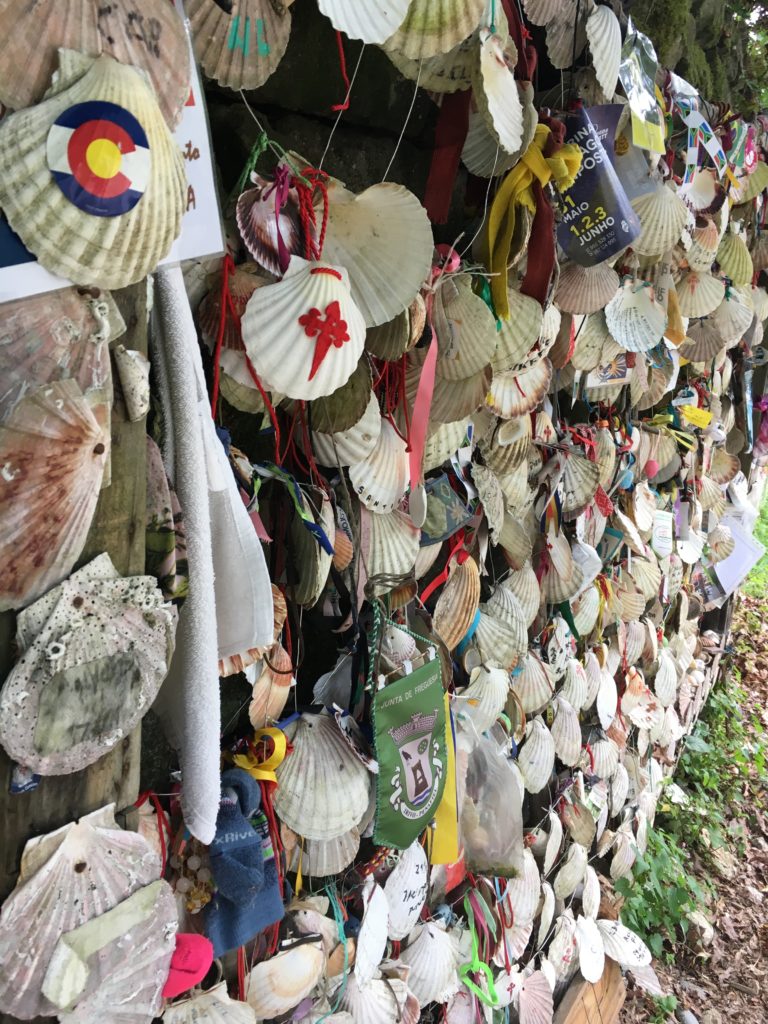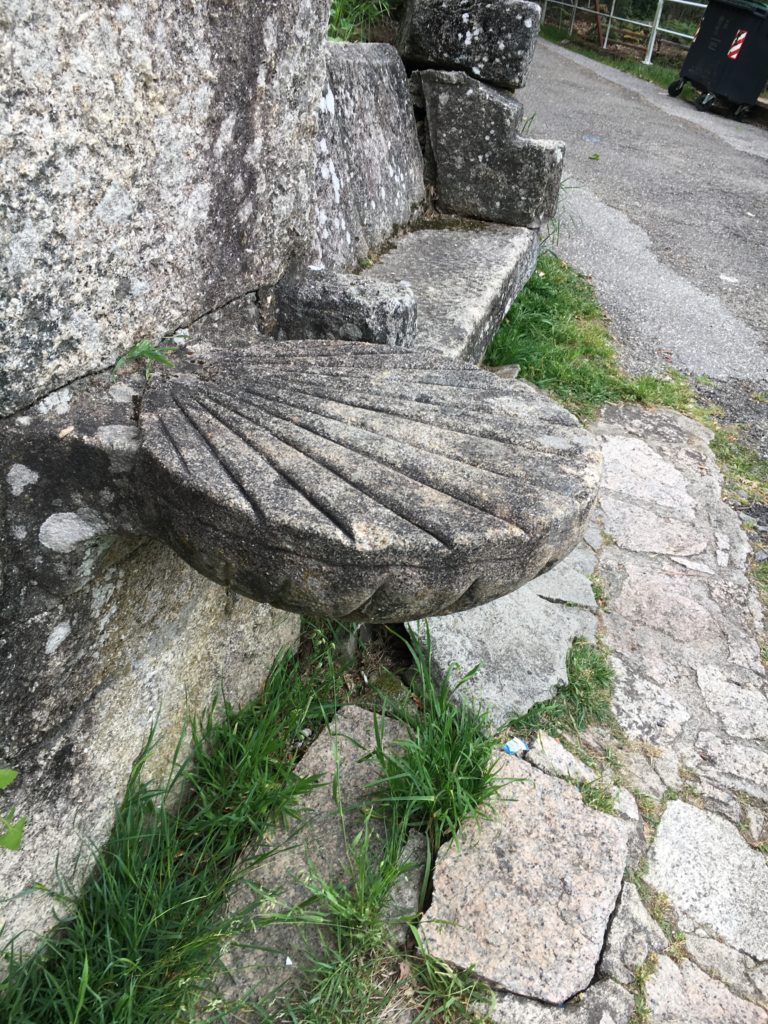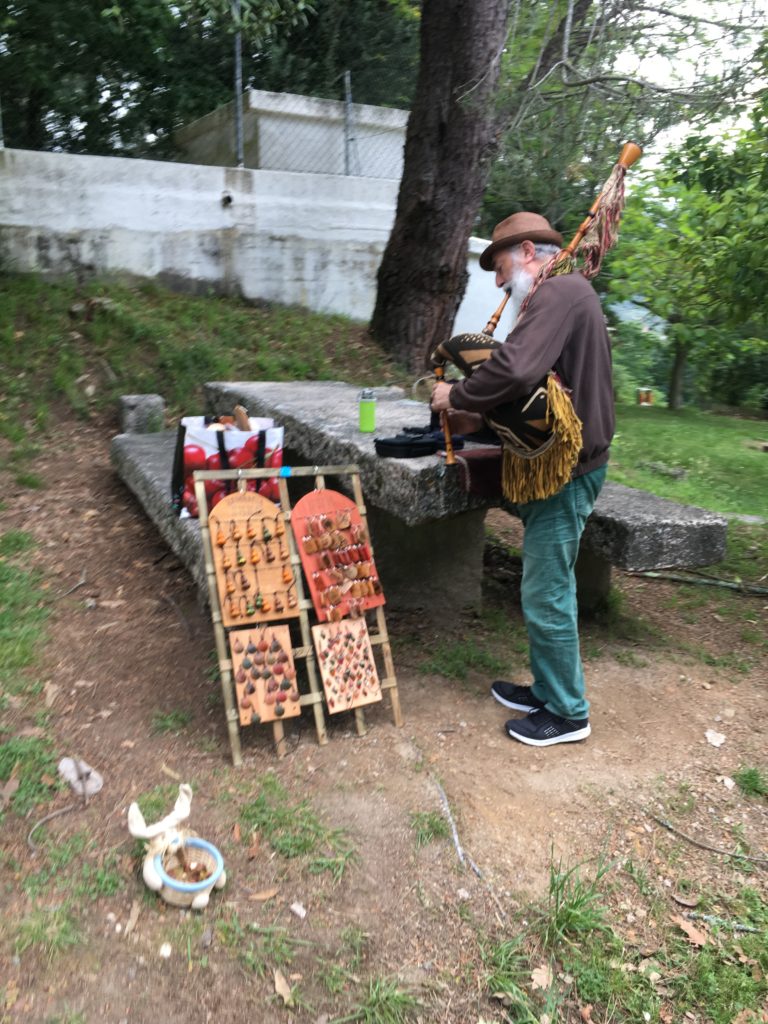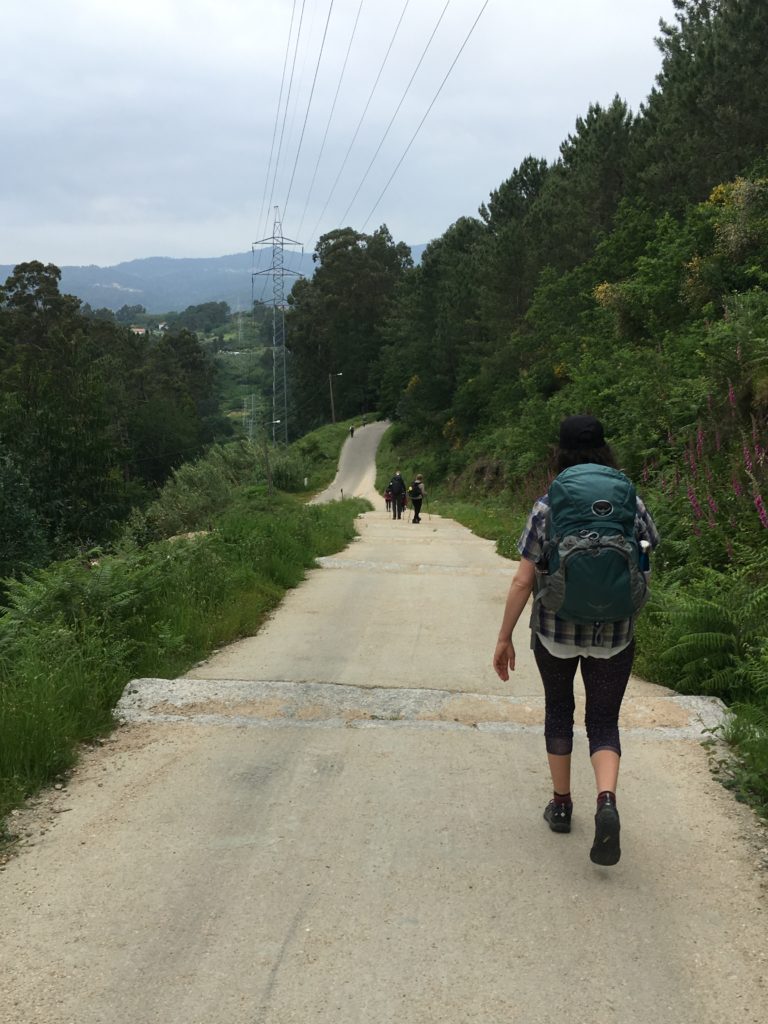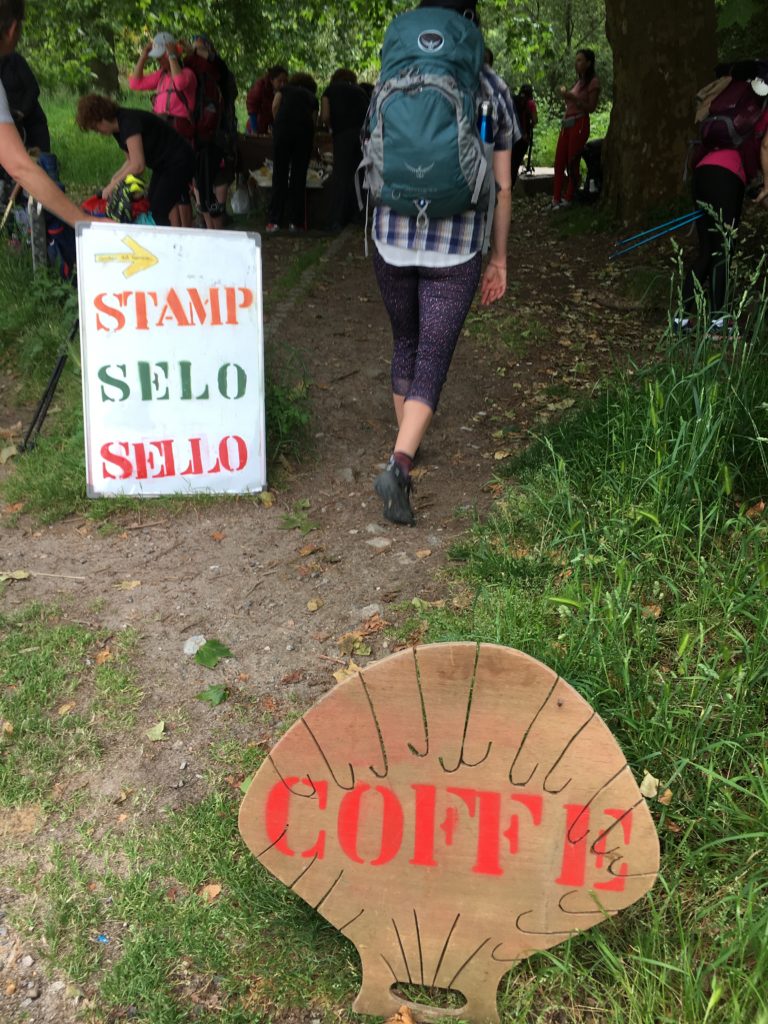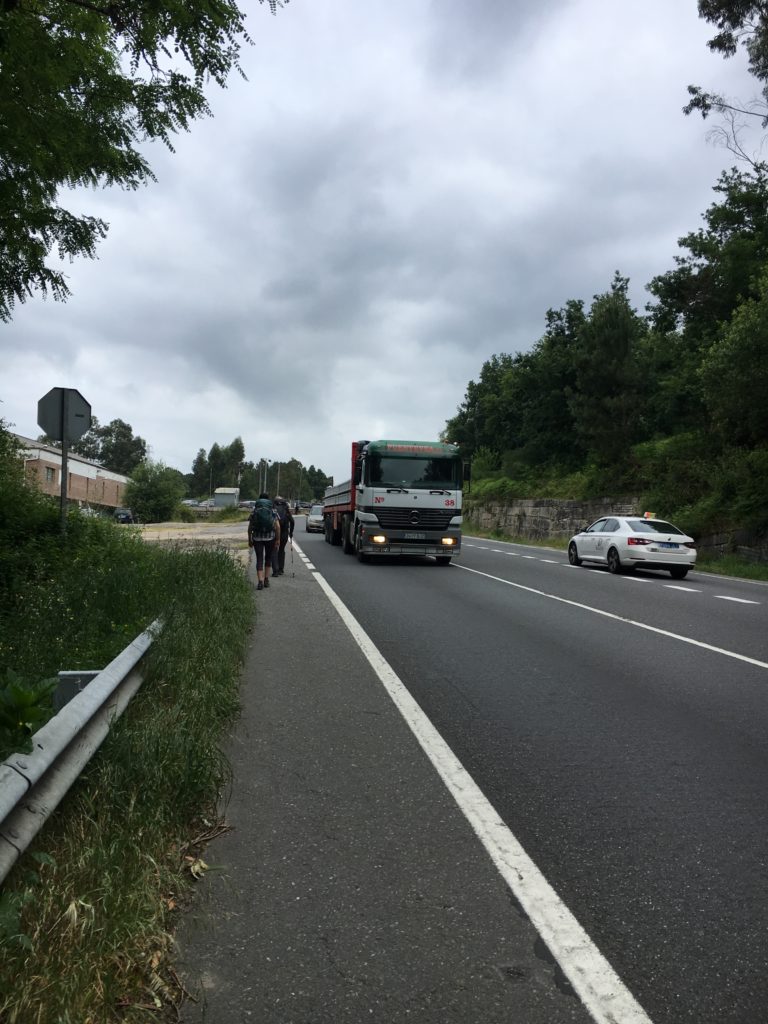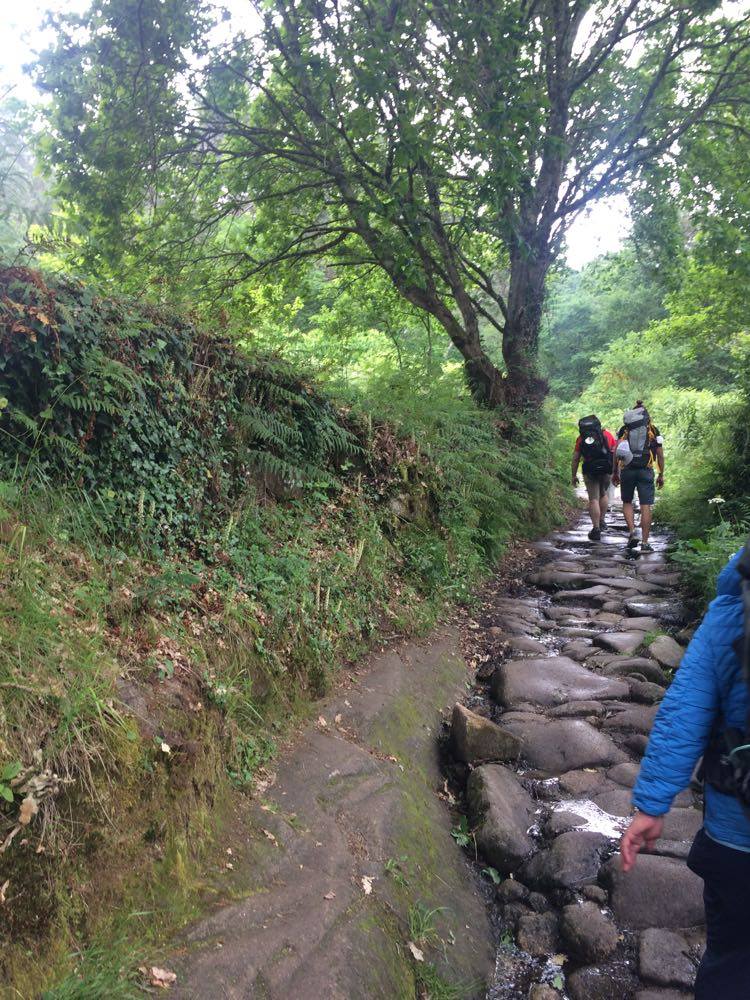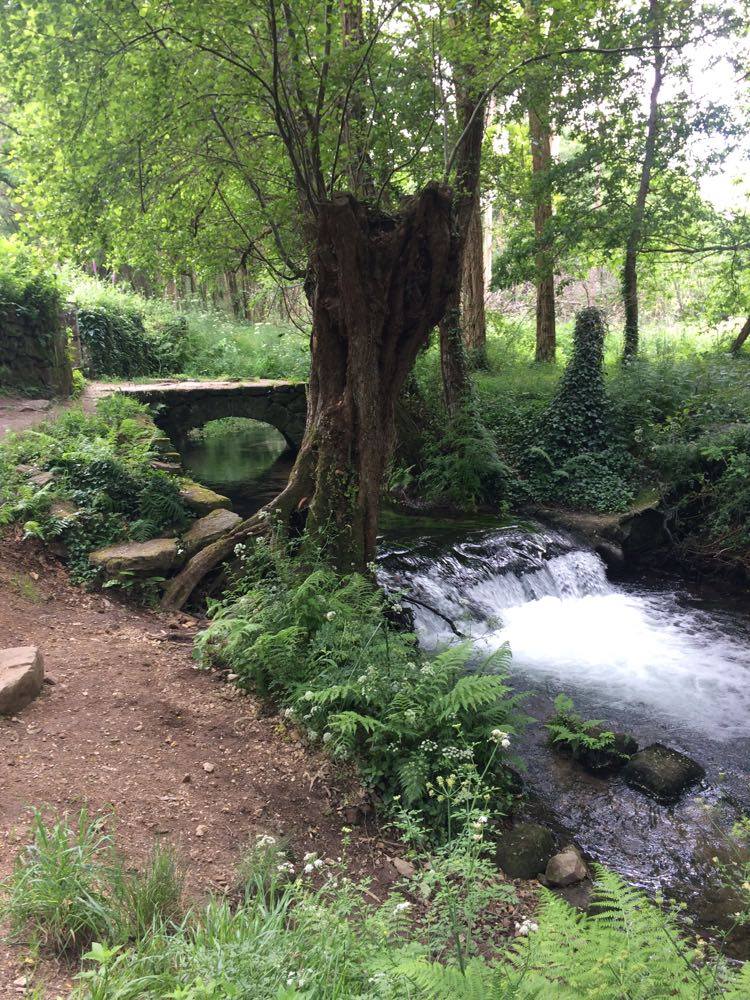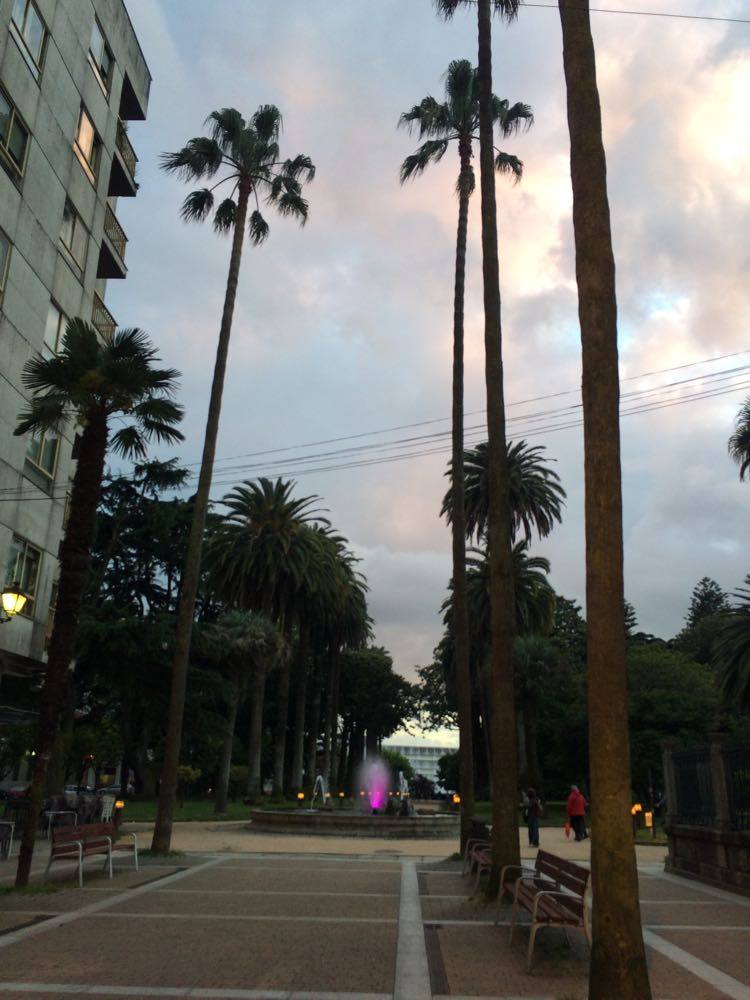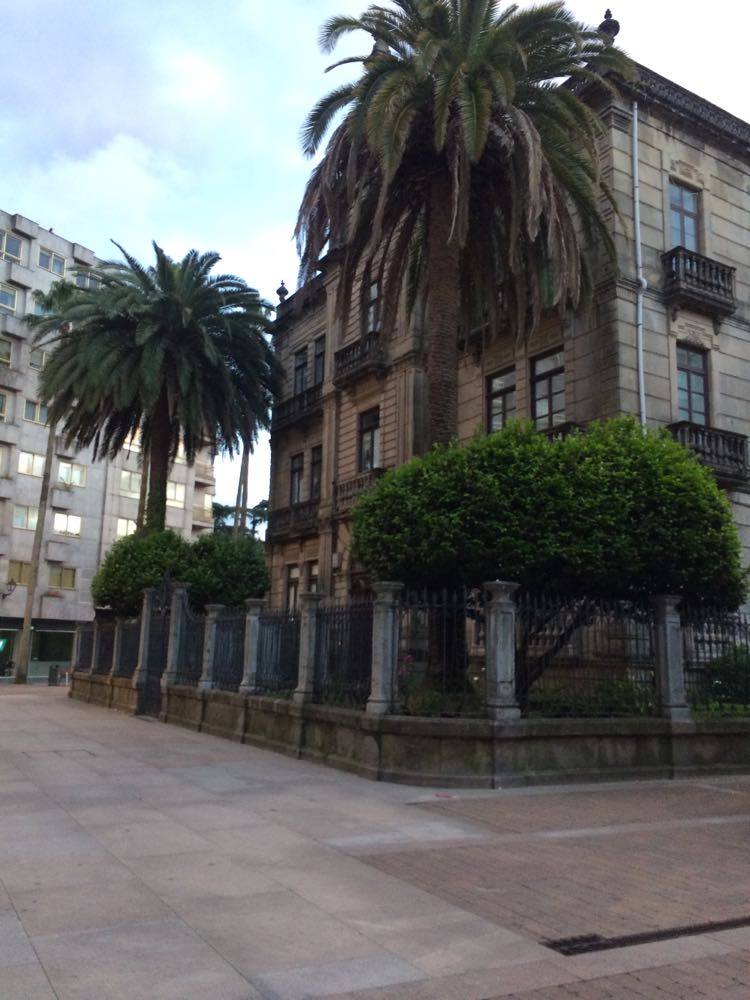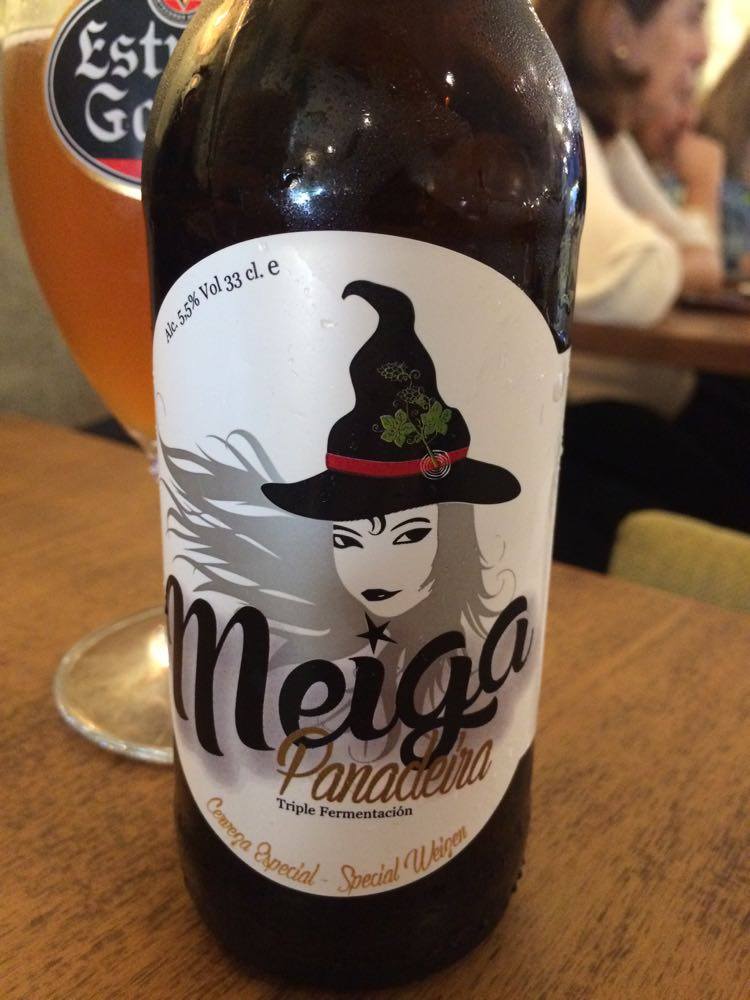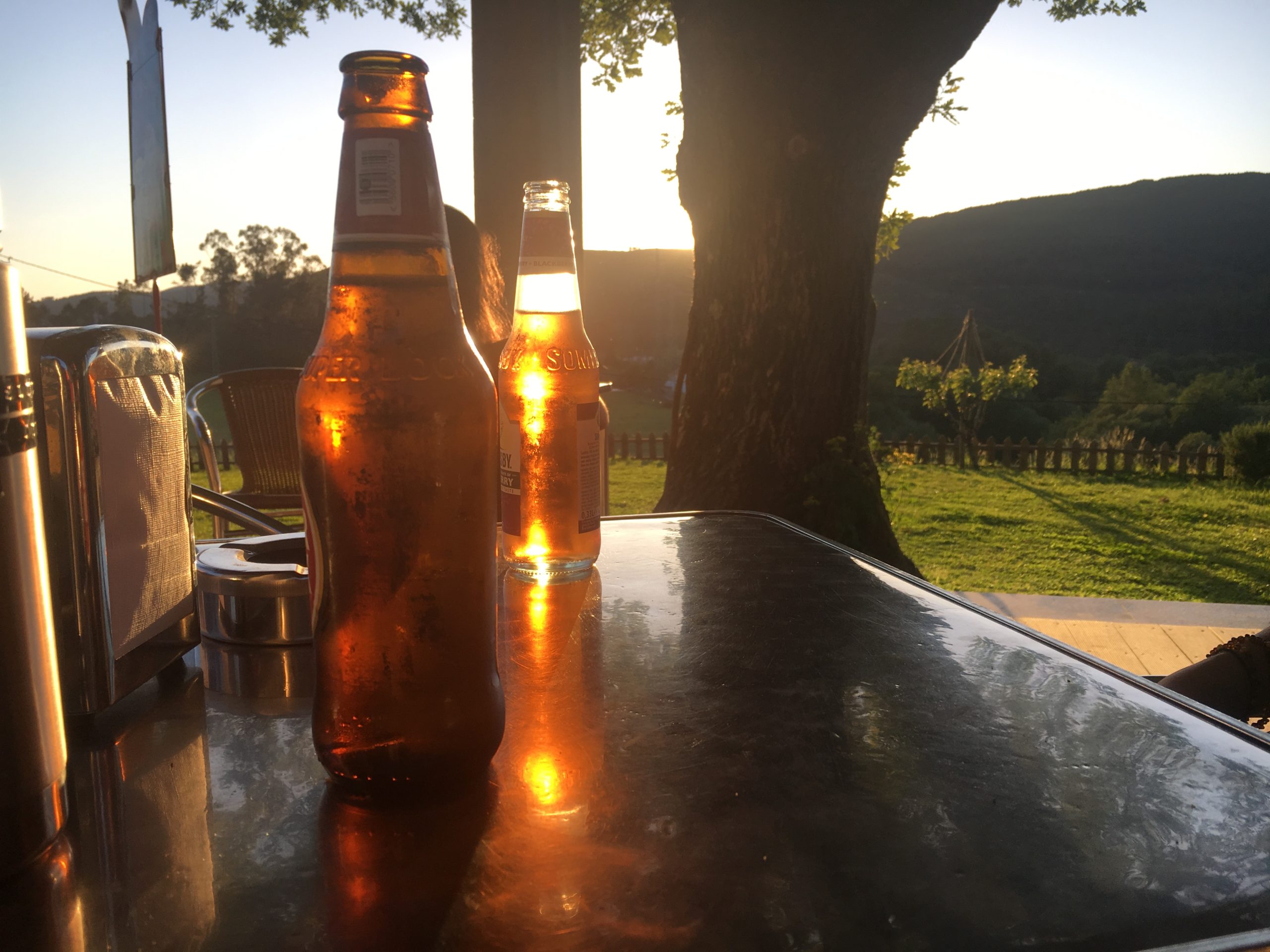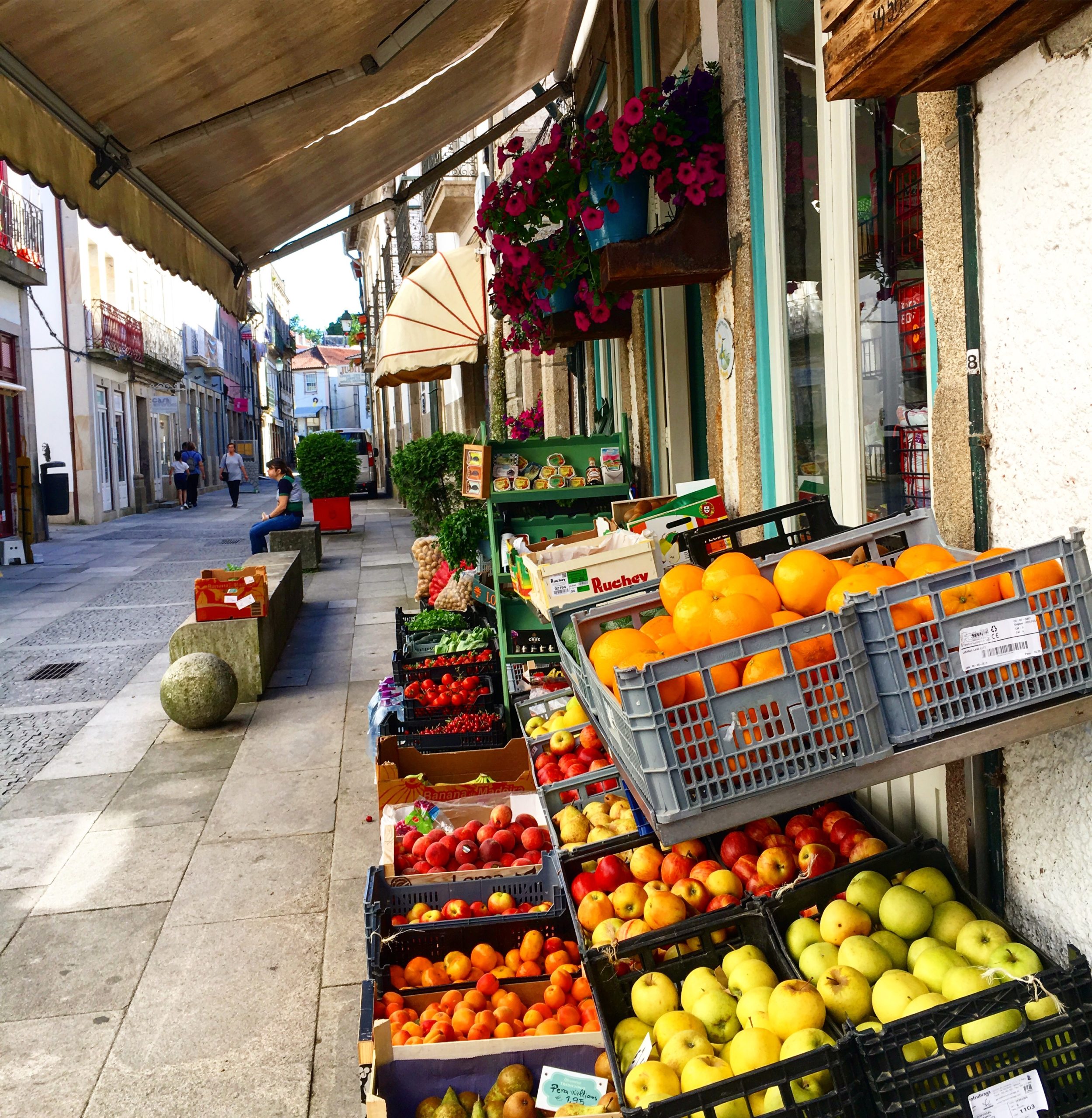
Camino Day 9 – Redondela to Pontevedra
7.5 hours walking, 23.4 km walked
A little later than everyone else in the hostel, we got up and hoisted urpacks on our backs for 7:30am, two bleary-eyed peregrinas making a stop at the lovely O Cafe a Vila, for a coffee and whatever that cakey thing is. I wish we could’ve stayed longer, but the road was calling, and so after about 20 minutes in the nicest cafe, we got on our way.
The top middle picture is a lavanderia, spots built in every village so that women could gather to wash clothes in the time before most houses locally had running water. They’re mostly deserted now, except for the occasional weary pilgrim taking advantage of the shade, but we saw a lot of them throughout this part of our walk.
The small stuffed moose has been travelling with me since my trip to Morocco in 2010, when he replaced a heavier, less travel-friendly moose that had gone on trips with me for a couple of years. The moose has slept under the stars in a camel hair tent and visited the Eiffel Tower in Paris, and spent this trip attached to my pack, occasionally decked out with wildflowers we picked along the way.
We had another overcast day, but overall we were thankful, as the path ahead was hilly, climbing around the foothills and up Alto de Lomba, back down to sea level, and then back up again, along ancient stone paths that have been the routes for pilgrims and locals for hundreds if not thousands of years.
On Alto de Lomba, we could hear pipe music, and only when we got close could we see that it was a Galician piper playing a gaita, the traditional bagpipes which are the forerunners of Scottish bagpipes and Uilleann pipes. It was a magical part of the morning, and we dropped a few coins in his hat (though didn’t buy any of the small souvenirs he was selling) before continuing on our way down again.
Along this part of the Camino, enterprising people have set up booths at rest points, like the piper above and this coffee stand. This one, which we stopped at briefly, is right before a dangerous crossing of a very busy road with lots of cargo trucks moving at speed. Pilgrims have to hop across the road at some speed, and then walk along an unprotected shoulder for a while before getting back on a safe path again, and it’s more than a little nerve-wracking.
We made a stop around 11am in Pontesampaio, another town grown up around a Roman bridge (I studied Roan history in university, so I love this stuff), and had fresh tortilla at A Romana, a cafe who’s sidewalk patio is right at the mouth of the bridge and where you get the thrill of seeing cars coming right at you. The food was good, though they did forget our order for a bit, and it’s a great people-watching place, as this part of the route is very busy with pilgrims from all over the world.
The walk now was through lovely, forested paths, with trees and walls covered in ivy, and lush countryside. A little sprinkling of rain here and there didn’t deter the souvenir pedlars. The paths were often uneven but picturesque, and it would have been a really nice walk, except that at this point you start to feel the pressure of other pilgrims, in front and behind, sort-of setting your pace by making it difficult to pass. If you can get past that, it’s great, but after our first week of walking mostly alone, it just got more and more weird to be walking with so many people. Our photos don’t make it look like a lot, because we were trying to get pictures without crowds.
We stopped at the Capela de Santa Maria in Bertola for a rest, and to look at this sweet, old local chapel, built in 1617 and still lovingly maintained with lit candles and fresh flowers.
At this point, close to Pontevedra, you have a choice; take the shorter, but less pleasant route along a busy and unlovely road, or the tree-lined river path. Because the Camino de Santiago has been a popular pilgrimage for about a thousand years, many of the roads that formed the original path have become main roads through cities, so they’ve often been re-routed where possible to make a more pleasant walk, instead of an hour of suburbs and industrial areas. We chose the forest route, slightly longer but certainly more pleasant.
We made it into Pontevedra around 3; you may have noticed that we took a long time to get there, with lots and lots of breaks along the way, because we had decided earlier that day to give ourselves the almost-unimaginable luxury of booking a hotel room. After the brief but scary altercation in the albergue the night before, and 8 nights without proper sleep or private bathrooms, we felt like we deserved the treat. And it’s a real relief to not have the stress of worrying about getting to the albergue, though it does take away some of the character of the Camino to stay in a regular old hotel.
City Express Hotel must be at least a hundred years old, with small rooms and nothing to make it stand out, but the rates were fine and it was so nice to have a room you could lock and a proper bath with hot showers!
We rested until about 7:30pm, then headed out to find a good dinner. Piada Romagnola is a greata restaurant with loads of good fresh food including plenty of vegetarian options. We tried Meiga, the local beer named after Galician witches, which was pretty good – we drank it a frequently over the rest of the Camino. Then we set out on a walk around Pontevedra, stopping to get some groceries and to check out the city.
Pontevedra is a beautiful city, with lots of great architecture and neighbourhoods, benefiting from its proximity to Santiago, the Ria de Pontevedra and the sea port, and an ancient university. We visited the Capela da Peregrina, the 18th century chapel dedicated to the Virgin Mary as a pilgrim, which has a floor plan in the shape of the scallop shell, symbol of pilgrims.
And of course, our old friend Sao Roque was there, as he had been along the way from Porto. He’s easy to identify because he wears pilgrim symbols (the hat, staff, drinking gourds, and scallop shells), is always accompanied by a dog, and is **always** showing a saucy bit of leg. He’s a patron saint of pilgrims as well as gravediggers, epidemics, bachelors, dogs, and falsely accused people, amongst others, so it’s always a good idea to send him a little prayer, because he’s probably got you covered.
We explored the city until about 9:30pm, passing a million little bars and cafes with the kind of welcoming spirit and enticing interiors you find in cities like New Orleans. I wanted to go into all of them and after 8 days with a curfew (albergues generally lock up by 10pm every night), this would’ve been the night to do it, but we were both beat, so we headed back to the hotel in hopes of a good night’s rest.

I’ll be updating this as I go along, but you can view a map which marks our approximate walking route and the places we stayed, ate, and visited here:
Follow our Caminho Portugues adventure!
Landing Day in Porto
Day 1 – Porto to Vila Cha
Day 2 – Vila Cha to Rates
Day 3 – Rates to Barcelos
Day 4 – Barcelos to Ponte de Lima
Day 5 – Ponte de Lima to Rubiaes
Day 6 – Rubiaes to Tui
Day 7 – Tui to Porriño
Day 8 – Porrino to Redondela
Day 9 – Redondela to Pontevedra (you are here)
Day 10 – Pontevedra to Caldas des Reies
When I’m done posting these, I’ll also post an article of my advice for anyone thinking of walking the Caminho/Camino, and I’ll link it here!
Photos by Candace Shaw and Samantha Shaw
